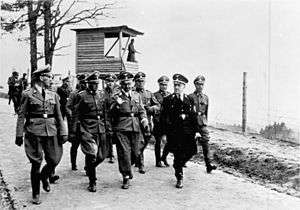Austrian SS
The Austrian SS was that portion of the SS membership from Austria. The term and title was used unofficially, especially before the year 1938. They were never officially recognized as a separate branch of the SS. Austrian SS members were seen as regular personnel and they served in every branch of the SS.
History
The term "Austrian SS" is often used to describe that portion of the SS membership from Austria, but it was never a recognized branch of the SS. In contrast to SS members from other countries, who were grouped into either the Germanic-SS or the Foreign Legions of the Waffen-SS, Austrian SS members were regular SS personnel. It was technically under the command of the SS in Germany, but often acted independently concerning Austrian affairs. The Austrian SS was founded in 1930 and, by 1934, was acting as a covert force to bring about the Anschluss with Germany, which occurred in March 1938. Early Austrian SS leaders were Ernst Kaltenbrunner and Arthur Seyss-Inquart.[1] Austrian SS members served in every branch of the SS, including concentration camps, Einsatzgruppen, and the Security Services. Political scientist David Art of Tufts University notes that Austrians comprised 8 per cent of the Third Reich's population and 13 percent of the SS; he states that 40 per cent of the staff and 75 per cent of commanders at death camps were Austrian.[2]
Austrian SS men were organized under the same manner as the Allgemeine-SS but operated as an underground organization, in particular after 1936 when the Austrian government declared the SS an illegal organization. One of the largest formations of the Austrian SS was the 11th SS-Standarte operating out of Vienna. The Austrian SS used the same rank system as the regular SS, but rarely used uniforms or identifying insignia. Photographic evidence indicates that Austrian SS men typically would wear a swastika armband on civilian clothes, and then only at secret SS meetings.

After 1938, when Austria was annexed by Germany, the Austrian SS was folded into SS-Oberabschnitt Donau with the 3rd regiment of the SS-Verfugungstruppe, Der Führer, and the fourth Totenkopf regiment, Ostmark, recruited in Austria shortly thereafter. Mauthausen was the first concentration camp opened in Austria following the Anschluss.[3] Starting with a single camp at Mauthausen, the complex expanded over time and by the summer of 1940 Mauthausen had become one of the largest labour camp complexes in the German-controlled part of Europe, with four main subcamps at Mauthausen and nearby Gusen, and nearly 100 other subcamps located throughout Austria and southern Germany, directed from a central office at Mauthausen.[4][5]
The Hotel Metropole was transformed into Gestapo headquarters in Vienna in April 1938. With a staff of 900 (80 per cent of whom were recruited from the Austrian police), it was the largest Gestapo office outside of Berlin. An estimated 50,000 people were interrogated or tortured there. Thereafter, the people would be deported to concentration camps throughout the German Reich.[6] The Gestapo in Vienna was headed by Franz Josef Huber, who also served as chief of the Central Agency for Jewish Emigration in Vienna. Although its de facto leaders were Adolf Eichmann and later Alois Brunner, Huber was nevertheless responsible for the mass deportation of Austrian Jews.[7]
Some cultural differences between Austrian and German SS men were present to the end of World War II, even though in theory the two countries contributed to a single SS. The issue was highlighted in 1943, when Austrian SS commanders were responsible for heavy losses in the first days of the Warsaw Ghetto Uprising and charged with negligence. Jürgen Stroop, the SSPF in Warsaw, overturned several courts martial (death) sentences since it was believed that Austrian members of the SS might rebel against the German officers who passed the sentences.
Still, Austrian SS members served in every branch of the SS, including Concentration Camps, Einsatzgruppen, and the Security Services. Besides Eichmann, who was one of the major organisers of the Holocaust, Amon Göth was another notable Austrian-SS member. He became the commandant of the Kraków-Płaszów concentration camp in Płaszów (who was portrayed in the film Schindler's List by Ralph Fiennes).[8][9]
See also
References
Citations
- ↑ Browder 1996, pp. 205–206.
- ↑ Art 2006, p. 43.
- ↑ Weale 2012, p. 107.
- ↑ Dobosiewicz 2000, pp. 191–202.
- ↑ Bischof & Pelinka 1996, pp. 185–190.
- ↑ Anderson 2011.
- ↑ Mang 2003, pp. 1–5.
- ↑ Weale 2012, pp. 144, 156, 157.
- ↑ Crowe 2004, p. 227.
Bibliography
- Anderson, Christopher (1 November 2011). "Crossing the Painful Threshold of Memory". Vienna Review. Retrieved 17 March 2016.
- Art, David (2006). The Politics of the Nazi Past in Germany and Austria. Cambridge; New York: Cambridge University Press. ISBN 0-521-85683-3.
- Bischof, Günter; Pelinka, Anton (1996). Austrian Historical Memory and National Identity. Transaction Publishers. ISBN 1-56000-902-0.
- Browder, George C (1996). Hitler’s Enforcers: The Gestapo and the SS Security Service in the Nazi Revolution. Oxford and New York: Oxford University Press. ISBN 978-0-19510-479-0.
- Crowe, David M. (2004). Oskar Schindler: The Untold Account of His Life, Wartime Activities, and the True Story Behind the List. Cambridge, MA: Westview Press. ISBN 978-0-465-00253-5.
- Dobosiewicz, Stanisław (2000). Mauthausen-Gusen: w obronie życia i ludzkiej godności (Mauthausen-Gusen: in defence of life and human dignity). Warsaw: Bellona. ISBN 83-11-09048-3.
- Mang, Thomas (2003). "Gestapo-Leitstelle Wien – "Mein Name ist Huber"" [Head Gestapo Agency of Vienna: "My name is Huber"] (PDF). Döw Mitteilungen (in German). Documentationsarchiv des Österreichischen Widerstands. 164: 1–5.
- Weale, Adrian (2012). Army of Evil: A History of the SS. New York; Toronto: NAL Caliber (Penguin Group). ISBN 978-0-451-23791-0.